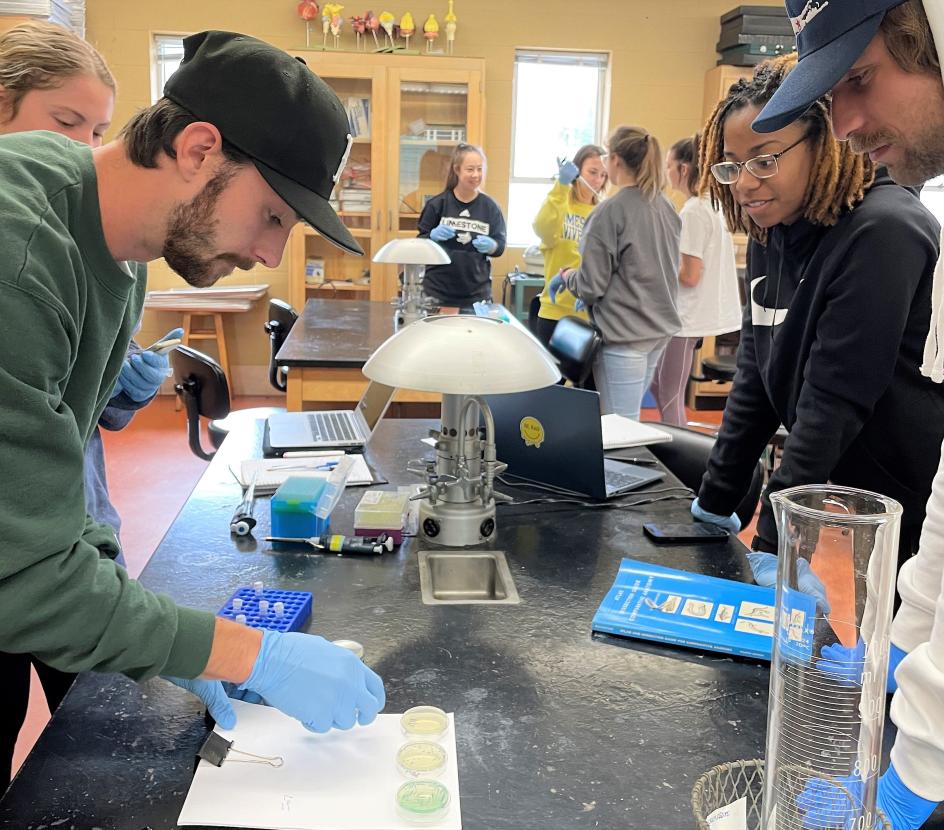November 4th, 2022
Limestone University Biology Class Completes Gene Editing Experiment

Limestone University students in a Molecular Cell Biology course have successfully performed the first CRISPR-Cas9 gene editing experiment as part of a teaching laboratory exercise on campus.
The class is being taught by Dr. Matthew Talbert, Limestone’s Associate Professor of Biology, Director of Premedical Studies, and Program Coordinator of Biology.
CRISPR-Cas9 represents a method by which scientists can quickly and relatively inexpensively perform precisely targeted alterations to the DNA contained within an organism's chromosome(s). Limestone’s experiment utilized Bio-Rad Laboratory, Inc.'s Out of the Blue CRISPR module.
“I am proud of our students and what they accomplish in the lecture hall and the laboratory, despite these being difficult to grasp topics,” Talbert said. “Any instructor for a molecular biology lab will tell you it is easy for things to go wrong, and protocols are often delicate. That every student group succeeded in editing the enzyme in these bacteria the first time we tried the approach shows the promise of this technology. It also shows how cost effective and accessible that it is becoming that we can do this on campus.”
Talbert noted that with CRISPR, scientists target an enzyme called Cas9 to the specific location on a chromosome they want to change, and this causes a break to occur in the DNA at that location. Then, the break can be patched using any DNA that the scientist wants to introduce, or the break can be used to cause deactivation of the gene at that location on the DNA. It can be used to cure diseases previously thought to be incurable.
Sickle cell disease impacts millions of people around the world, most of which are of African descent. It is associated with the formation of sickle-shaped red blood cells that are not effective in transporting oxygen and moving well throughout a human body, which can cause many life-threatening medical complications and result in a significant amount of pain.
“Individuals suffering from sickle cell disease have a ‘broken’ adult hemoglobin gene, which is used to carry oxygen in the bloodstream, due to a genetic mutation with which they were born,” Talbert explained. “However, they frustratingly have a fully functional hemoglobin gene that was active while they were a fetus, but that usually is silenced and turned off by our cells with further development. CRISPR-Cas9 has been used to deactivate a gene in patient bone marrow that does that silencing of fetal hemoglobin. The impact is an effective cure for sickle cell disease – as this suddenly reactivated and circulating fetal hemoglobin then compensates for the function of their ‘broken’ adult hemoglobin.
Talbert's class at Limestone has used the new technology to precisely deactivate the function of a gene for an enzyme called Beta-galactosidase in the bacterium Escherichia coli (E. coli).
“It is important to try to give the students exposure to what is happening right now in science and medicine whenever we can, while also not losing sight of foundations,” Talbert said. “As we grow in the sciences at Limestone, I hope we will see more firsts and continue to dream as big as possible.”
Talbert has served as a Biology faculty member since 2012, serving at the University of Louisiana at Monroe before coming to Limestone in 2021. He earned his Bachelor of Science degree, with a concentration in Medical Humanities, from Davidson College. He received his Ph.D. in Molecular Medicine from Wake Forest University and his Postdoctoral Associate from the State University of New York at Stony Brook.
